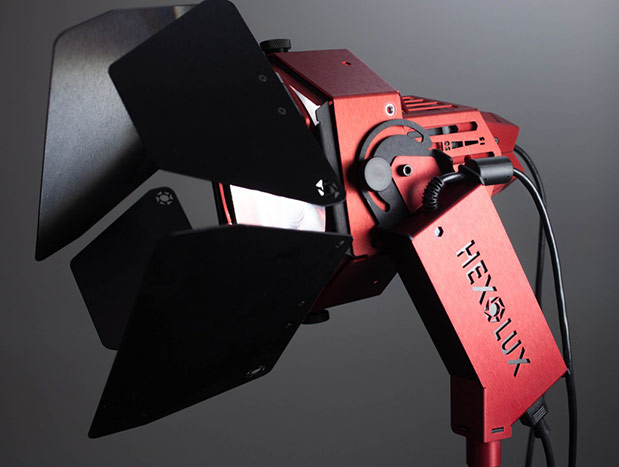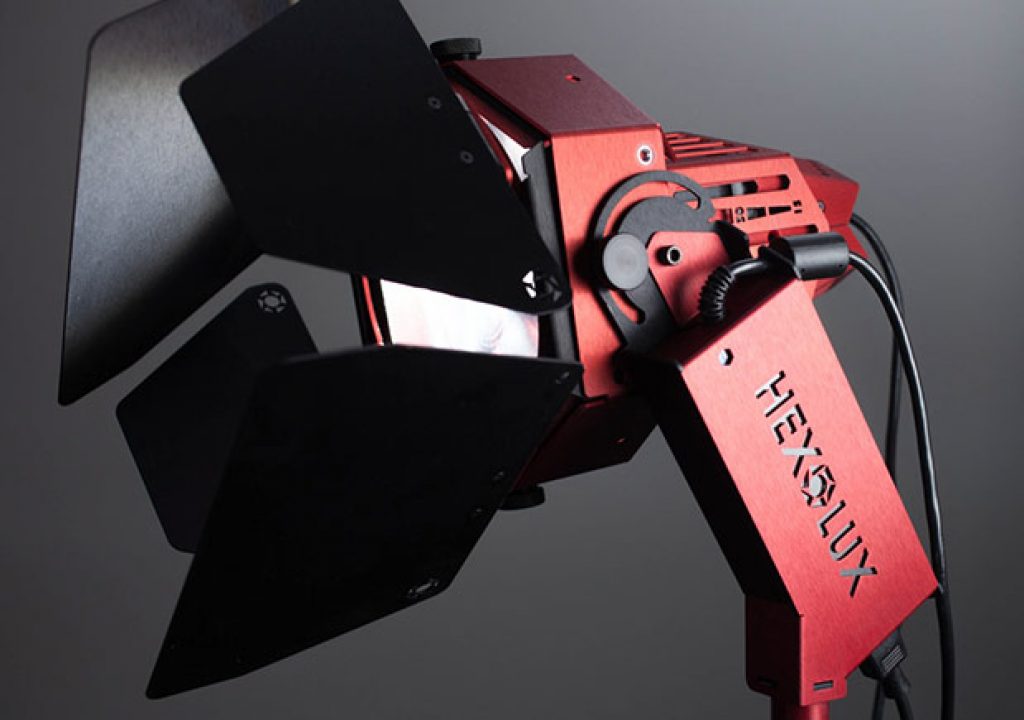The Hexolux D7 LED light ($2400) is one of those lights that breaks ground because it can take the place of many conventional lights you’ve been using for years without the compromises that have typically characterized LEDs.
The D in D7 stands for “Daylight”…or very close to daylight, at least. Rated at 5300 kelvin, there’s not quite as much blue in the D7 as a light that delivers a more conventional 5600 kelvin color temperature. Some purists may be able to see that in footage, but I don't think it's much of an issue, and besides, there are plenty of other daylight balanced lights that miss the mark by a couple hundred kelvin as well. More importantly, I noticed that the D7 suffered from no appreciable green shift, which until recently has been rare for LED lights. Balance your camera for daylight and white looks white. That means you won’t have to take the time to gel the D7 to remove green, won’t lose light output in the process, and will have an easier time mixing the D7 with other lights you have on hand.

The Hexolux produces a flattering beam thanks to its 7-inch fresnel lens (made of durable, replaceable plastic), and you can loosen a knob on the fixture to spot the beam down to 11 degrees or flood it to 77. The fresnel lens also eliminates all the micro-shadows typically cast by the multiple point sources of conventional LED panels, and gives the light reasonably clean, crisp cuts when you shape it with barn doors and flags — not as clean or crisp as my beloved Dedolights manage, but if you’re used to working with an Arri fresnel, you’ll feel at home with the Hexolux.
Unlike the LEDs of yesteryear, the Hexolux also has considerable power. It draws 150 watts when powered from the wall, but according to photometric tables, gives you a notch or two less light output than an Arri 650w tungsten fixture. For instance, at 5 ft with a 30 degree beam angle, an Arri delivers 910 foot-candles, while the Hexolux does 770. At 10 feet, the Arri does 228 while the Hexolux does 224. I’m comparing numbers reported on the Hexolux and Arri web sites, not my own hands-on tests. But I did get a chance to do a side-by-side comparison of the Hexolux and a Joker Bug 200 HMI. At 10 feet in full flood, the D7 measured f5.6 on my light meter, whereas the Joker with a frosted fresnel lens measured f5.6 8/10. So the Joker was a little more than 3/4s of a stop brighter in its most diffused state. When I spotted the Hexolux down to 11 degrees, however, it measured an F22, which was the same as the Joker with only its PAR beamer installed, but no lens. And the Hexolux’s spot had a much cleaner shape and more consistent brightness than what the Joker produces with just a beamer.
Finally, the D7 enjoys the typical benefits you’d expect from LEDs — low heat (you can always handle it without gloves) and the ability to dim it with negligible color shift.
The Hexolux and a Joker Bug 200, for size comparison.
I had a chance to work with the D7 on a couple of real-world projects, and here are a few other impressions from my time with the light:
- There are three major components to the light fixture, which can be used together or separately. There’s the fresnel lens housing, and then there’s the LED light head (the “Lux Illuminator”) that fits into the lens housing, and which you can slide back and forth to focus the light. Finally, there’s an arm or “yoke”, which attaches the lens housing to a light stand, and includes the light’s power circuitry. Taken all together, these components make the D7 a little big. Not so heavy at 5.5 pounds, but bulky, as you can see from the side-by-side photo with a Joker Bug 200. That bulk can become a bit of a drag as you try to find a good packing solution for multiple lights.
- Hexolux sells a tungsten version of its light with a dead-on 3200 kelvin rating. It's called the T7 and sells for the same price as the D7 ($2400 with barn doors). The company also sells a version with a 5” fresnel lens (the D5 and the T5) for $100 cheaper than the 7” editions. The same Illuminator light head can slide into either the 5” or 7” housing.
- The Illuminator light head is designed to work with or without the fresnel lens. You can unscrew a knob, and slide the head completely out of the lens, and then attach it directly to the arm/yoke. You might do this to give the light as much kick as possible before bouncing it into a reflector or through diffusion. In fact, the Illuminator has a convenient slot that lets you attach an umbrella.
- Thanks to the D7's unique hexagonal form and its light-weight body, you can attach multiple lights (with or without lenses) together into a honey-comb configuration. That lets you boost light output dramatically while keeping the effects of a single light source, more or less. So if you have three or more Hexoluxs, they may spare you from having to keep a bigger, more specialized light on hand as well.
- Here's something else unusual: You can tilt the Hexolux's fresnel lens within its housing, which lets the fixture cast more light on one side of the beam than the other. That lets you light a subject or scene from an angle, but even out the beam so that it’s just as bright at the far side as the near side of the beam. A practical application would be to light a green screen more or less evenly with one light parked to the side, or set up a light to cover an actor evenly as they move from a far position to a closer one. I haven’t seen this kind of feature in a light before, and while it won’t revolutionize lighting, it’s definitely an out-of-the-box feature that can come in handy from time to time.
Loosen a knob and you can slide the Illuminator forward and back to focus your beam. A digital readout tells you exactly how much you've dimmed the light.
- The light has a couple of nice features for dimming. For starters, it can dim linearly from 1-100%, and you can dial in that exact percentage using a small knob and digital readout on the back of the light head. But you can also push that knob in once to switch to f-stop dimming, where you output is measured in 1/10 increments of an f-stop. That's a nice touch that lets the light speak the same language as the DP and Gaffer. Another nice touch is the ability to quickly flick the knob to the left, which turns off the light, but remembers the dimming value you had dialed in last. When you turn the light back on, it’s exactly as you set it before.
- If you want to work with softboxes, you're at a disadvantage because there's currently no speed-ring available to attach them to the D7. Hexolux says they're working on a speed-ring, but doesn't have a target date. In the meantime, they do sell a 20″ hexagonal softbox ($250) that quickly pops open and collapses (a bit like an umbrella or Lowel's Rifa line of softboxes). But 20″ is on the small side, so a speed-ring would definitely be welcome.
- The Hexolux works with DMX, so you can control the light or multiple lights centrally.
- You can buy an Anton Bauer or V-mount battery plate ($250) to run the Hexolux from a battery. On DC battery power, the light loses a bit of oomph (downsizing from 150 watts to 125) but it’s still nice to have the option to power the light for 30-60 minutes away from a wall socket.
- The light does have an internal fan, which in my experience comes on every 10 or so minutes while the light is running at full power. The fan is noticeable from a couple of feet away, but I highly doubt it would interfere with audio recordings or distract an actor.
This is your only softbox option, for now. It attaches just like barndoors, but a speed-ring is in the works.
THE FINAL VERDICT
The D7 (and its tungsten cousin, the T7) is an impressive light, able to fill a lot of different roles on a set with no compromises in terms of light quality or control. The only thing that will give you pause is the light’s $2400 price tag. For roughly the same money, you could have four conventional Arri 650 fresnels. You could have one of K5600’s new Joker Bug Evolution fixtures, which are smaller, let you swap out bulbs for either daylight or tungsten, and can work well with softboxes. For a little more money, you could have an Arri LC-7 LED unit, which has about 25% more power than the Hexolux and makes gels obsolete by letting you dial in any color temperature, not to mention other color effects.
These are all compelling alternatives, but of course, they bring their own compromises as well. Arri 650w fresnels hog power, run hot, don’t dim and don’t work with DMX. A Joker Evolution can’t produce nearly as clean and controllable beam as the Hexolux, can’t run on a battery and can’t conveniently dim. And an Arri LC-7 is a much bigger, heavier fixture that will probably require more crew to manage.
So pick your poison. But personally, I like the Hexolux’s unique blend of features. It’s a light that’s very easy to work with, and produces a nice looking beam with good creative control.
Pros
- 150w power draw rivals 650w conventional output
- Fresnel lens with broad spot/focus range (11-70 degrees)
- No noticeable green
- Can remove lighthead from lens for more output
Cons
- Want tungsten? Use gels or get T7 model
- Pricey
- A little bulky
Helmut Kobler is a Los Angeles-based DP and cameraman. www.losangelescameraman.com.


